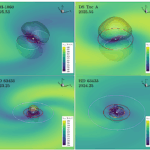Gamma-ray bursts (GRBs) are among the most powerful explosions in the universe, second only to the Big Bang. The majority of these bursts are observed to flash and fade within
phys.org
Leading X-ray space telescopes XMM-Newton and XRISM have spotted a never-seen-before blast from a supermassive black hole. In a matter of hours, the gravitational monster whipped up powerful winds, flinging
Using the James Webb Space Telescope (JWST), an international team of astronomers has observed an elliptical galaxy known as NGC 4486B. Results of the observational campaign, published Dec. 16 on
An international team of astronomers has achieved a first in probing the early universe, using the James Webb Space Telescope (JWST), detecting a supernova—the explosive death of a massive star—at
A small, icy moon of Saturn called Enceladus is one of the prime targets in the search for life elsewhere in the solar system. A new study strengthens the case
Astronomers have used the Keck Observatory’s DEIMOS multi-object spectrograph to observe a nearby galaxy cluster designated RXC J0032.1+1808. As a result, they found that the cluster undergoes a major merging
Astronomers have confirmed the first known triple system in which all three galaxies host actively feeding, radio-bright supermassive black holes.
India’s space agency launched its heaviest ever payload on Wednesday, with Prime Minister Narendra Modi calling the deployment “a significant stride” for the space sector.
For most, getting into a car is a task that can be done without assistance. Yet for those whose destination is the moon, the process of getting inside and secured—in
With plans to launch the massive Starship from Florida next year, SpaceX defended its commitment to airspace safety after a Wall Street Journal article claimed an explosive mission in early
-
 01From Polymerization-Enabled Folding and Assembly to Chemical Evolution: Key Processes for Emergence of Functional Polymers in the Origin of Life
01From Polymerization-Enabled Folding and Assembly to Chemical Evolution: Key Processes for Emergence of Functional Polymers in the Origin of Life -
 02Panasonic Leica Summilux DG 15mm f/1.7 ASPH review
02Panasonic Leica Summilux DG 15mm f/1.7 ASPH review -
 03Two Black Holes Observed Circling Each Other for the First Time
03Two Black Holes Observed Circling Each Other for the First Time -
 04How New NASA, India Earth Satellite NISAR Will See Earth
04How New NASA, India Earth Satellite NISAR Will See Earth -
 05And Thus Begins A New Year For Life On Earth
05And Thus Begins A New Year For Life On Earth -
 06Astronomy Activation Ambassadors: A New Era
06Astronomy Activation Ambassadors: A New Era -
07SpaceX launch surge helps set new global launch record in 2024





